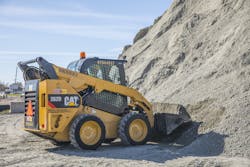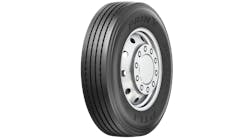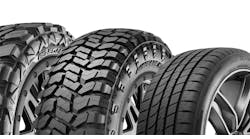New construction and new equipment are behind the growth, according to manufacturers. “The OTR marketplace in North America is forecasted to grow as high as 6.5% until the year 2022,” says Ray McElroy, manager of OTR technical services for BKT USA Inc. “Infrastructure projects to general building will have a large portion of that increase. New construction equipment with newer sizes will increase the demand for replacement tires also.”
Ryan Lopes from Alliance Tire Americas Inc. likewise sees an uptick in demand. “With investment in construction and infrastructure — particularly public spending — running high and a strong economy driving plenty of activity among construction and material handling machines, small OTR tires are strong performers.” Lopes is national product manager-material handling and solid tires for Alliance.
Several manufacturers identified the rental industry as a source for new customers. “The rental industry has been growing since the economic recovery in the late 2000s,” says Mike Dembe, executive director, product management - construction at Camso Inc. “There’s been a lot of action on this side and it shows no signs of slowing down.”
Titan International Inc.’s Johni Francis notes that when technology like telematics and fleet management software were introduced for the construction market, the programs were integrated into larger equipment and fleets. “Today’s available technology is now more user-friendly and cost-effective compared to manually managing tires on smaller fleets and compact equipment,” says Francis, who is global OTR product manager for Titan.
BKT’s McElroy says information that is immediately available from a dealer to the end user allows smart purchases, partnerships and long-term performance of a brand or multiple brands to be reviewed solely from tracking technology. “This will continue as tracking technology improves and more end users see the cost-related value.”
Modern Tire Dealer asked manufacturers for an update on trends in the small OTR tire market. In addition to Rasey from Continental, McElroy from BKT, Lopes from Alliance, Dembe from Camso, and Francis from Titan, four other companies responded. They are: Eric Matson, global field engineering manager, Goodyear Tire & Rubber Co.; Justin Brock, marketing manager for construction and Tweel, Michelin North America Inc.; Bill Dashiell, senior vice president-commercial tire division, TBC Brands LLC; and Tom Clauer, senior manager of commercial and OTR product planning for Yokohama Tire Corp.
Trend toward radials
The shift from bias to radials was one of several areas manufacturers noted in their response to MTD’s question on trends in the U.S. market for small OTR tires.Lopes, Alliance: Equipment OEMs for skid steers, backhoe loaders and material handling equipment all forecast increases in production and sales numbers going forward. The U.S. rental industry, which is home to most of the equipment using small OTR tires, is forecasting a growth in revenues which would indicate that demand for tires should remain strong through the year. However, these revenue growth rates are not as high as they were in 2018 and are expected to move further south, which could imply that things could be getting tougher in the long run.
We are also seeing great interest in our radial OTR tire line, most of which is built for 25-inch rims. Construction, earth moving and grading applications that put on relatively high mileage can see the benefit of tires that last longer, reduce fuel consumption, and increase the transfer of horsepower to the ground.
McElroy, BKT: Trends that have hit the U.S. market in recent years are 1) building stronger products with different star ratings for carrying and haul capacity; 2) deeper tread depths for more available tread use which extends the life of the tire based on hours per 32nd; and 3) new metric sizing, which offers a wider tread for more stability while in use. Products with deeper tread depths that meet load carrying capacity requirements and provide stability seem to be on the rise. Most manufacturers have developed tires to fit this grouping, and we feel this trend will continue.
Dembe, Camso: The American Rental Association forecasts growth of 4.7% from 2017-2021 in the U.S. and growth of 4.6% from 2017-2021 in Canada. For dealers, this means they should adapt to and serve the needs of this industry. This has been challenging as many rental locations don’t order tires in advance; they rely on local dealers to stock tire needs for just-in-time delivery. Independent dealers therefore need to plan and purchase to have inventory on hand for rentals. Furthermore, they must train their sales team on the equipment and service needs for this segment.
The industry is shifting from pneumatic to solid, especially within skid steer loaders and telehandler machine types. Solids are also becoming more common on wheel loaders for certain severe service applications.
Currently 11% of North American construction wheel positions are solid technology, according to Smithers Rapra research. We’re also witnessing a shift from tires to tracks. 60% of skid steer loaders sold in North America are now on rubber tracks, according to Yengst research.
Rasey, Continental: The rate of radialization continues to grab a larger share of the overall market as bias demand is stable, but has certainly diminished.
The overall trend toward more specialized tires, such as lower profile, wide-base sizes such as 65-series tires, is picking up momentum in the market. In 65-series tires, the aspect ratio of sidewall height to tire section width is 65%.
In addition, there is a trend toward more specialized types of 25-inch tires, such as L4, L5 designation products and even all-season or snow tread OTR tires which fit specific product niches.
Matson, Goodyear: Today, there are more brands offering solutions for the small radial market. Despite the choices, end users continue to seek out premium performance when it comes to traction, stability, tread wear and retreadability. At the same time, end users are still seeking the lowest operating cost.
Brock, Michelin: In the construction segment, we are seeing a growth in compact equipment. There has been a steady growth in CTL (compact track loaders) machines and mini excavators. To take full advantage of this growth, Michelin recently acquired Camso, which represents a great opportunity to better service our customers.
We also see three additional trends that will impact tire dealers. The first is productivity advancements through digitalization and technology. The construction industry has lagged behind many sectors such as agriculture and manufacturing in technological capabilities that influence productivity. Many companies are now focused on services and equipment advancements. These advancements are making sites more efficient, safer, increasing productivity and putting all the knowledge in the end user’s hand.
In regards to services, it’s all about getting the data in an easy-to-use platform to help the construction companies increase the productivity/uptime of their equipment and operation. This allows them to monitor the performance and analyze detailed equipment and tire information.
Companies are also looking at ways to improve the equipment through other advancements including autonomous machines, electric machines, airless tires and much more.
The changes are happening fast. Customers will expect more than just tires from tire dealers. Servicing and data interpretation will continue to grow. Dealers who incorporate these solutions into their offer and utilize these technologies and data to bring value to the customer will differentiate themselves in the market.
Another trend we see is equipment rental in construction. This could increasingly shift the purchase decision from the end user to the rental company.
The third trend is the challenges in recruiting and retaining skilled equipment operators and service technicians.
Dashiell, TBC: Although telehandlers have been around since the 1970s, their popularity has started to gain momentum in recent years. Initially designed to compete with small cranes at a much more reasonable price point, the list of uses and attachments seems to grow every year. Since they are used on all types of terrain, tires are extremely important to the telehandler’s performance. We have seen increased demand for G-2/L-2s in 25-inch sizes that are specifically designed to enhance telehandler performance.
Francis, Titan: The market for small OTR tires has been shifting from bias to radial tires. Supply and prices are positive right now for radial tires due to increased demand in applications such as road building and infrastructure work. Radial tires for small-to-medium size equipment are proving to be an attractive, cost-effective option for end users in these applications.
Constructed with steel belts to protect the tread area, radials offer greater load-carrying capacity and generate less heat when hauling at higher speeds and longer distances. This makes them a good fit for haulage, loaders and graders. Bias tires are a better fit for job sites with more stationary work and less travel.
Clauer, Yokohama: The demand in the market for smaller diameter OTR tires, whether radial or bias, remains very healthy.
As in the larger OTRs, we are seeing a change to the metric aspect ratio for the 25-inch and below wheel diameter products. Original equipment manufacturers have challenged tire manufacturers by requesting new metric sizing. This is done partially to maximize operating capacity, handle the additional torque, increase the footprint and reduce the compaction traditional sizes create.
More and more tire manufacturers are introducing dual marked products (E3/L3). These products are made possible by the advanced technology in casing design and new compound discoveries. These dual marked products help simplify dealers’ product lines, save floor space and lower inventory cost by stocking just one part number instead of two. It benefits the end user similarly as they can use one part on multiple pieces of equipment.
Challenges and opportunities
MTD also asked manufacturers to discuss issues related to heavier equipment, higher horsepower machines, environmental concerns, specific applications or other areas that dealers should be aware of.
Lopes, Alliance: Every industry is interested in economies of scale and machinery that can do more work in less time, so over time we will see some increase in tire size. For instance, we see the 12-16.5 skid steer size becoming increasingly popular compared to the 10.16.5 size used on smaller machines. Additionally, some OEMs have increased the pitch-circle diameter on select skid steer models on the 12-16.5 and 14-17.5 tire sizes from the traditional 8-bolt-by-8 inches apart to 8-bolt x 10.75 inches apart to improve performance on the bigger machines.
The trend we’re more excited about is increased interest in tires that deliver specific performance attributes in any size. Instead of hearing, “Do you have a tire in this size?” we’re increasingly hearing, “Do you have tire that is built with superior cut and chipping resistant properties that lasts a long time on concrete?” That’s recognition that not all tires are created equal, and an acknowledgement of the value of innovation in design, compounding and manufacture. It’s a growth of opportunity to differentiate not only brands, but specific lines or tires that bring extra value to the marketplace. And it emphasizes relationship marketing rather than just selling on price.
It can be a challenge to sell innovations like better compounding or longer service life because the customer can’t see it. But it’s worth the effort; this is the opportunity to differentiate not only the tire you are selling, but the value that you are providing to your customer’s business.
McElroy, BKT: Specific applications now require a specific, well-built tire for those requirements that will allow maximum value and wear.
Over the past few years while specifications of equipment seems to have steadied in terms of extreme carrying capacity, it will not be long before new heavier, faster equipment comes into the marketplace. Tire manufacturers and tire dealers will have to adjust construction of the tire and sales to match the new equipment.
Regarding environmental concerns, the belief is that we should all work together to create healthy environments. Dealers across the U.S. seem to be making their own choices in how their tires are recycled and that is a trend that will continue.
Dembe, Camso: Machines offer never-seen-before performance, carry heavier loads and travel at faster speeds, therefore requiring high-performing tires. Yet customers don’t want to pay more for the tires, which represents a challenge for tire manufacturers and dealers.
Along with heavier and higher horsepower machines comes increasing demands on tire life and durability.
Manufacturers need to continue to adapt to the changing construction equipment landscape to provide products capable of handling the increased demands, helping to keep to a minimum the environmental footprint of old tires.
Today, we’re seeing tires that fail for the wrong reasons. Trying to ensure that products reach their end of life is among our top concerns. This is done through education, first of dealers, who are able to recommend the right product for the right application to their customers. Step two is educating users on how to operate machinery and carry out regular maintenance.Additionally, manufacturers are able to positively affect fuel efficiency on machines by producing tires with lower rolling resistance. As fuel efficiency is becoming more important in the construction industry, we’re seeing low profile products increasing in numbers and tires adapting with new tread patterns and compounds.
Rasey, Continental: Every year, construction equipment manufacturers continue to innovate machines that provide more efficient production, while minimizing cost of operation. This includes the engine/power plants, fuel efficiency and greater loading/hauling capacities. That means we have to keep pace with these developing trends to enhance our products to support optimal machine performance. That’s why we continue to add advanced technologies in tire construction, compounding and handling characteristics to support new machine requirements.
Matson, Goodyear: Tire dealers should work with end users to understand the types of conditions their tires will be running in. Goodyear makes several product lines that fit the same equipment, but the recommended tire may vary based on how hard or soft the underfoot conditions are. For example, the Goodyear RL-4K is a great fit for harder underfoot conditions where cutting may be more prevalent, whereas the Goodyear TL-3A+ is more appropriate for soft underfoot conditions such as earth, mud and sand.
Additionally, the right tire recommendation can provide other benefits for end users, such as the ability to haul heavier and/or faster, maximize tread wear and reduce downtime. These abilities boost the end users’ productivity and create value.
Brock, Michelin: There is a big push in the construction industry toward optimization and getting more out of the machine. This includes OEMs looking at autonomous equipment, electric machines and more connected equipment. OEMs are starting to look at tires that have reduced rolling resistance and reduced fuel consumption.Tire manufacturers are constantly innovating products for tire performance. The premium solutions optimize the fleet performance and deliver optimal results. Tires are engineered to deliver performance through tire durability, casing and tread design as well as compounds and materials. Performance is delivered through safety, traction and longevity. The key is to note that with more connected machines, end users will demand more from the tire dealers.
Francis, Titan: As construction equipment has grown in the last couple decades — in size, power, weight and speed — so has the need for off-the-road tires that can keep up with the increased demand. In order to adapt to today’s heavier equipment, Titan has engineered certain tires to reinforce the increased load carrying capacity. With new enhanced designs, tires can carry heavier loads in certain applications.
It is important to train tire technicians to understand that every tire is manufactured differently, and therefore the tires must be managed differently. In fleets with multiple tire manufacturers, it is critical for the fleets to maintain the manufacturers’ recommended air pressures and not use the same psi across all tire brands. This will ensure the fleet is getting the maximum amount of hours out of the tires.
Clauer, Yokohama: Equipment manufacturers have vastly improved engine and drivetrain technology. This equipment is more fuel-efficient and delivers ever-increasing torque. This increased torque can create issues for the tires traditionally used.
Issues like tire/wheel slip or spin can manifest into bead damage and loss of air. If left unchecked, it could lend the tire completely unserviceable. Tire manufacturers combat this with advanced bead technology. This technology employs items such as multiple bead bundles, along with special compounding and others to help manage the additional torque. This is just one of the many issues tire dealers have to be aware of and deal with.
Impact of technology
MTD asked manufacturers how the technology and information management being implemented by end users is changing the small OTR segment for tire dealers.
Lopes, Alliance: Technology of any sort is a drive for efficiency. Rental fleet machines equipped with GPS equipment tracking their every move and forklifts fitted with fleet management systems all provide volumes of information that allow end users to drill down to the root cause of issues being faced. Access to such information also allows tire dealers to identify better, application-specific products to meet the demands of each application. Every industry is looking for greater efficiency and better return, and that absolutely includes generating more ROI from their tires.
McElroy, BKT: Technology is at the forefront of end users working with their dealers, to ensure the proper application-based tire is being used, maximum hours are being run and that cost can be compared from one manufacturer to another.
This relationship between tire dealers, end users and technical information will continue to grow as more brands, sizes and applications change.
Dembe, Camso: Technology is opening the gateway to easier access to data. For construction machines on smaller OTR tires, customers are not interested at this point. The technology is too pricey for the ROI. However, on the bigger machines, there are a lot of benefits and interest: reduced downtime, more predictive selling, etc. We’re expecting this trend to make its way in to the smaller machines segment, but it’s hard to tell when the interest will rise.
Rasey, Continental: Adaptation of advanced technology solutions is moving fast for most end user customers. One good example is our ContiPressureCheck that comes as standard fitment in all of our radial tires.
ContiPressureCheck measures both heat and air pressure, which translates into better fleet operations. For OTR tires, this means optimal air pressure maintenance and catching small problems before they manifest into bigger issues. Proper air pressure maintenance also helps keep our tires at their designed optimal shape, which enhances handling on the road, and contributes to improved fuel efficiency in any machine.
Matson, Goodyear: As technology accelerates, end users are better able to track and view their tire performance. Tire management systems help end users understand the health of their fleet and the performance of their tires. Goodyear dealers frequently use Goodyear’s EMTrack to consult with their end users on best practices in tire management and tire selection that turn into real value for the end user.
Francis, Titan: Most fleets likely already have access to technology that can improve upon their tire management practices. Fleet management software can calculate optimized haul routes. Site simulation software can ensure the equipment fleet is perfectly suited to the operation and its production goals. Telematics software helps predict and plan for service, track locations for better fleet utilization and even helps identify needs for operator training.
The most successful way for a fleet to utilize this technology is to enlist the expertise of a trusted tire manufacturer or dealer. ■




